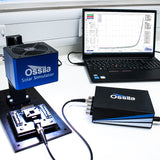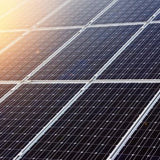Tandem Solar Cell

A tandem solar cell is a subtype of multijunction solar cells. They are crucial in photovoltaics (PV) research and industry. By stacking multiple layers with different bandgaps, tandem cells capture more of the solar spectrum. This allows them to surpass the fundamental efficiency limit (radiative efficiency limit) of single-junction cells and convert sunlight more efficiently.
Tandem solar cells are available in two configurations: 2-terminal and 4-terminal, each with its efficiency limits. These tandem solar cells were conceptualized in 1970s. And currently, these have achieved efficiencies of up to ~40% PCE. Despite challenges in manufacturing and cost, ongoing research aims to optimize their performance and stability, making them a promising route for enhancing the efficiency and adoption of clean solar energy.
Tandem Solar Cells: Overcoming The Fundamental Efficiency Limit
No solar device can achieve 100% power conversion efficiency (PCE) due to effects like heat loss and other fundamental loss mechanisms. Single junction solar cells, with one p-n junction, have a fundamental limit on their PCE of roughly 33.7%. This efficiency limit is known as the radiative efficiency limit (also known as the Shockley Queisser Limit or the detailed balance limit).
PCE of a solar cell device is given as:

Here VOC is the open circuit voltage, JSC is the short circuit current, FF is the fill factor of the device, and Pin is the incident solar power (standard irradiance is 100 mW/cm2, usually provided by a standardized solar simulator).
VOC, JSC, FF and therefore PCE are dependent on the bandgap (Eg) of the semiconductor material. The plot of the maximum attainable PCE vs Eg suggests that the maximum attainable PCE (~33.7%) for a single junction PV device happens at an optimum Eg ~1.34 eV.
This limit arises due to fundamental loss mechanisms listed below:
- Transmission of photons (photon energy < Eg)
- Thermalization of charge carriers (photon energy > Eg)
- Recombination of charge carriers
- Parasitic resistance losses.
One smart and effective way of overcoming this detailed balance limit is to stack solar cells with different bandgaps. This way devices can use light from a wider range of the solar spectrum. This reduces the transmission and thermalization losses. A device stacking two solar cells (a wider bandgap and a narrower bandgap) is known as a tandem solar cell.
Tandem Solar Cell Configuration
Tandem solar cells use more than one layer to improve efficiency. The top cell is made of a wide band gap material, which absorbs high-energy light. This layer transmits lower-energy light to the bottom cell. The bottom cell has a narrower band gap and absorbs this remaining light. This design allows tandem solar cells to capture a broader spectrum of sunlight, converting more energy into electricity compared to single-junction cells.
There are two configurations of tandem solar cell:
- One with four terminals (4T) called the stacked tandem configuration
- Another with two terminals (2T) called the monolithic tandem configuration
The stacked 4T tandem devices are simpler to make and can extract more power than the 2T devices. This is because 2T devices require current matching while 4T devices don’t.
However, the installation of 4T tandem devices is more difficult and expensive as they need double the amount of PV system components. Therefore, monolithic 2T tandem devices are generally preferred in research and industry.
Multijunction solar cells are typically considered as 2T devices with three or more junctions in series. However, they can have multi-T configurations too. Such devices have the potential to achieve more efficiency than the two junctions based tandem solar cells.
For 4T devices, the resultant PCE is simple the summation of the PCE of each individual sub-cell. However, as 2T devices require current matching, the JSC remains constant across both sub-cells, while the VOC of the sub-cells add up. Therefore, the PCE is calculated from the following equation.

Fundamental Limits of Tandem Solar Cells
It is impossible to make any solar cell with 100% efficiency. There are realistic limits to the PCEs of the tandem and multijunction solar cells, even though some losses are minimized to a certain extent. Tandem solar cells have potential to achieve a maximum of 42% PCE under standard solar spectra. Similarly, a triple junction solar cell can achieve a maximum of 49% PCE, and an ideal infinite junction device can attain a maximum of 68% PCE .
History of Tandem and Multijunction PV
-
Early Research (1970s-1980s):
Scientists initially explored the concept of tandem solar cells by stacking two different semiconductor materials with complementary absorption properties.
-
Development of III-V semiconductors-based Tandem PV (1980s-1990s):
GaAs tandem solar cells emerged as one of the first successful implementations of tandem technology with a PCE of 20%. GaAs has a near-optimum bandgap of 1.4 eV. Researchers achieved high efficiencies by combining GaAs with other semiconductors like InP or GaxIn1-xP with bandgaps in the range of 1.8-1.9 eV.
-
Progress in Silicon-based Tandem Cells (2000s-Present):
While GaAs-based tandem cells demonstrated impressive efficiencies, their high manufacturing cost limited widespread commercial adoption. In contrast, silicon solar cells (Eg ~1.12 eV), which are more abundant and cheaper to produce, dominated the market. Researchers continued to explore ways to improve silicon-based tandem solar cells by integrating them with other materials like perovskites or III-V semiconductors.
Current Status of Multijunction and Tandem Solar Cells
- III-V semiconductor technology:
- Tandem: GaInP/GaAs monolithic solar cells have currently achieved a certified PCE of 32.8%.
- Multijunction: Triple junction InGaP/GaAs/InGaAs solar cells have certified records of 37.9% PCE and 5-junction solar cell (2.17 eV/1.68 eV/1.40 eV/1.06 eV/0.73 eV) have recorded a 38.8% PCE.
These III-V semiconductors-based tandem and multijunction devices, with such high efficiencies, are typically used for space applications due to their high manufacturing costs.
- Silicon technology:
- Tandem: Currently, GaAs/Si (stacked) have recorded 32.8% efficiency while the GaAsP/Si (monolithic) struggles at 23.4% PCE. Furthermore, perovskite/Si monolithic tandem solar cells have recorded a respectable 33.9% PCE.
- Multijunction: GaInP/GaAs/Si stacked triple junctions have achieved a 35.9% PCE while its monolithic version struggles at 25.9%. Perovskite/perovskite/silicon triple junction have recently achieved a record PCE of 24.4%.
GaInP/GaInAs/Ge; Si triple junction solar cells, with a PCE of 34.5%, are widely used in the space applications.
III-V/Si monolithic tandem and multijunction mainly suffer in PCE because of the lattice mismatch defects.
- Perovskite technology:
- Tandem: Perovskites have tuneable bandgaps and that sets the stage for all-perovskite tandem and multijunction devices. All-perovskite monolithic tandem solar cells have reportedly achieved 29.1% PCE. While they can compete with silicon solar cells in terms of PCE, but their poor operational stability is still a big issue.
- Multijunction: All-perovskite monolithic triple junction solar cells have recently hit the 25.1% PCE.
All-perovskite monolithic multijunction solar cells are attractive because of their potential low-cost manufacture, potential for high efficiency, flexibility and lightweight. Current research focuses on making them more efficient and stable to compete with silicon solar cells in terrestrial applications and III-V multijunction in space applications. The major problem with perovskite/perovskite/silicon and all-perovskite multijunction solar cells is the wide bandgap perovskite in the top cell undergoes halide segregation under continuous light illumination, resulting in poor performance of the device. Research continues to eliminate this halide segregation.
Tandem Solar Cell Efficiencies
For your convenience, we have tabulated the above mentioned efficiencies in the table below. In the column 'Structure', J refers to the junctions (e.g. 3J means triple junction).
| Technology Type | Structure | Max Certified Efficiency |
| GaInP/GaAs | Monolithic 2J | 32.8% |
| InGaP/GaAs/InGaAs | Monolithic 3J | 37.9% |
| GaAs/Si | Stacked 2J | 32.8% |
| GaAsP/Si | Monolithic 2J | 23.4% |
| Perovskite/Si | Monolithic 2J | 33.9% |
| GaInP/GaAs/Si | Stacked 3J | 35.9% |
| GaInP/GaAs/Si | Monolithic 3J | 25.9% |
| Perovskite/perovskite/silicon | Monolithic 3J | 27.1% |
| GaInP/GaInAs/Ge | Monolithic 3J | 34.5% |
| Perovskite/perovskite | Monolithic 2J | 29.1% |
| Perovskite/perovskite/perovskite | Monolithic 3J | 25.1% |
The efficiencies mentioned in this section are mostly based on the Solar cell efficiency tables (Version 63) by Green et al .
Conclusion
Tandem and multijunction solar cells promise to deliver high-efficiency solar power, which is essential for making clean and affordable electricity a reality. While their efficiency potential is exciting, there are challenges to overcome. Manufacturing these cells, especially those using III-V materials, is expensive and complex. Optimizing their performance and ensuring stability, especially for perovskite-based cells, is also tricky. Plus, deploying them at scale presents its own set of hurdles. But ongoing research is focused on solving these issues. Once resolved, tandem and multijunction solar cells could fully realize their enormous potential, helping to drive the widespread adoption of clean energy.
Solar Simulator

Learn More
 Solar Cell Testing
Solar Cell Testing
Solar simulators are used for measuring the efficiency of solar cells and modules. To characterize how solar cells will perform in the real world, it is vital that you use a solar source that effectively mimics the spectrum of the sun.
Read more... Solar Cells: A Guide to Theory and Measurement
Solar Cells: A Guide to Theory and Measurement
A solar cell is a device that converts light into electricity via the ‘photovoltaic effect’. They are also commonly called ‘photovoltaic cells’ after this phenomenon, and also to differentiate them from solar thermal devices. The photovoltaic effect is a process that occurs in some semiconducting materials, such as silicon. At the most basic level, the semiconductor absorbs a photon, exciting an electron which can then be extracted into an electrical circuit by built-in and applied electric fields.
Read more...
References
- Detailed balance limit of the efficiency of tandem..., Vos et al., Journal of Physics D: Applied Physics (1980)
- Solar cell efficiency tables (Version 63), M. A. Green, Progress in Photovoltaics (2023)
- Triple-junction solar cells with cyanate in ultrawide-bandgap perovskites, S. Liu, Nature (2024)
- Halide homogenization for low energy loss in 2-eV-bandgap..., J. Wang (2023)
Further Resources
Nelson, J. (2003). The Physics of Solar Cells. doi:10.1142/p276
Shockley, W., & Queisser, H. J. (1961). Detailed balance limit of efficiency of p-n junction solar cells. Journal of Applied Physics, 32(3), 510–519. doi:10.1063/1.1736034